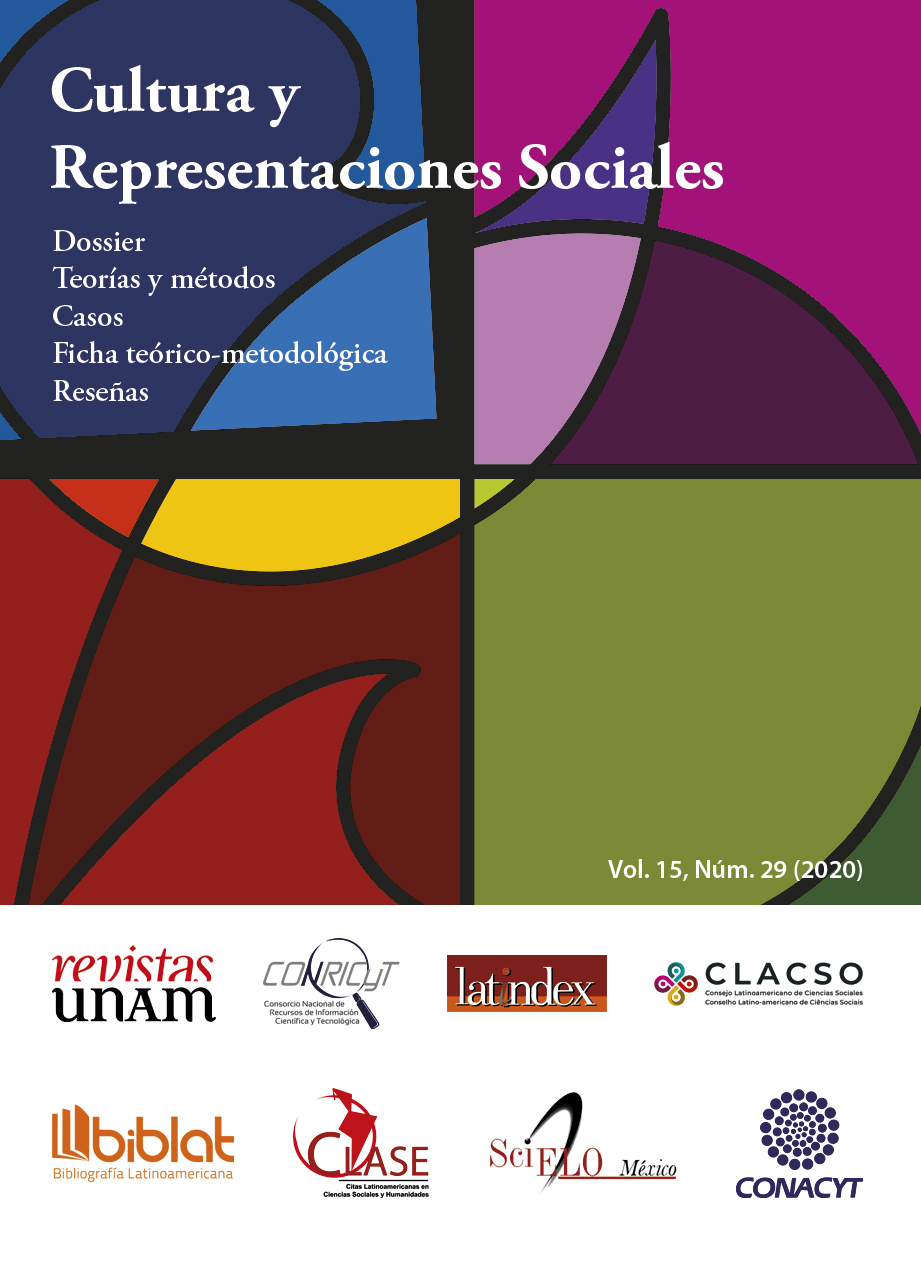Abstract
The purpose of this work is to identify the image they share of the scientists featured in the television series The Big Bang Theory (sitcom). The study is based on the theory of social representations, since according to Moscovici (1979), social representations are an organization of images and language that personify or symbolize acts and situations and become common through different sources including the media. 297 students from the 6 thematic centers of the UdeG participated and answered a questionnaire with open questions, analyzed through a content analysis. A complex figurative nucleus was identified among the students’ responses in which the scientist’s image is based on his attributes or qualities in an ambivalent way: on the one hand, neutral qualities predominate, and on the other, there are negative attributes oriented towards stereotypes with which scientists are commonly associated. Most of the students report not identifying with any of the protagonists, and perhaps this is one of the possible causes, in combination with others, that weaken their conviction to profess a scientific discipline.References
Barnett, M., y Kafka, A. (2007). Using science fiction movie scenes to support critical analysis of science. Journal of College Science Teaching, 36(4), 31-35.
Barnett, M.; Wagner, H.; Gatling, A.; Anderson, J.; Houle, M.; y Kafka, A. (2006). The impact of science fiction film on student understanding of science. Journal of Science Education and Technology, 15(2), 179-191.
Bednarek, M. (2012). Constructing ‘nerdiness’: Characterisation in The Big Bang Theory. Multilingua, 31(2), 199-229.
Bonaut, J. y Grandío, M. (2009). Los nuevos horizontes de la comedia televisiva en el siglo XXI, Revista Latina de Comunicación Social, 64, 753-765.
Davis, C.; Tilley, F.; y Hague, P. (2010). P4_6 the pot noodle proposal. Journal of Physics Special Topics, 9(1), 1-2.
Domínguez, S. (2017). Los científicos “modernos”: la serie de televisión The big bang theory, Global Media Journal Mexico, Volumen 14, Número 26, 1-23.
Domínguez, S. (2012). Significados de la ciencia en estudiantes universitarios. Aproximaciones a las representaciones sociales de la ciencia, del científico y de la actividad científica. Guadalajara, México: Universidad de Guadalajara.
Efthimiou, C. J., y Llewellyn, R. A. (2006). Avatars of Hollywood in physical science. The Physics Teacher, 44, 28-33.
Farland-Smith, D.; Finson, K.; Boone, W. J., & Yale, M. (2014). An Investigation of Media Influences on Elementary Students Representations of Scientists, Journal of Science Teacher Education, 25, 355-366.
Fraknoi, A. (2003). Teaching astronomy with science fiction: A resource guide. Astronomy Education Review, 1(2), 112-119.
Fung, Y. (2002). A comparative study of primary and secondary school students’ images of scientists. Research in Science and Technological Education, 20(2), 99-213.
Galán, E. (2006). Personajes, estereotipos y representaciones sociales. Una propuesta de estudio y análisis de la ficción televisiva. Revista ECO-PÓS, 9(1), 58-81.
Galvão, D. P. (2009). Os nerds ganham poder e invadem a TV. Revista Científica Intr@ciência, 1(1), 34-41.
Gottfredson, L.S. (1981). Circumscription and compromiso: A developmental theory of occupational aspirations. Journal of Counseling Psychology, 28(6), 545, 579.
Guerrero, I. J., y González, I. J. (2010). Análisis de contenido de los estereotipos presentes en “The Big Bang Theory”. Razón y Palabra, 72(15,Mayo-Julio), 3-18.
Jovchelovitch, S. (2007). Knowledge in Context: Representations, Community and Culture. London: Routledge.
Knippels, J.; Severiens, S. y Klop, T. (2009). Education through fiction: Acquiring opinion-forming skills in the context of genomics. International Journal of Science Education, 31(15), 2057-2083.
Laprise, S., y Winrich, C. (2010). The impact of science fiction films on student interest in science. Journal of College Science Teaching, 40(2), 45-49.
Li, R., y Orthia, L. A. (2016). Communicating the nature of science through The Big Bang Theory: Evidence from a focus group Study. International Journal of Science Education, Part B, 6(2), 115-136.
Li, P. (2016). Communicating science through entertainment television: How the sitcom The Big Bang Theory Influences audience perceptions of science and scientists. Thesis submitted por the degree of Doctor of Philosophy in Science Communication at The Australian National University.
Marková, I. (2003) Dialogicality and Social Representations. The Dynamics of Mind. Cambridge, UK: Cambridge University Press.
Martín-Serrano, M. (1994). La producción social de comunicación. México: Alianza Universidad Textos (2ª. Edición revisada).
Milanick, M. A., & Prewitt, R. L. (2013). Fact or fiction? General Chemistry helps students determinethe legitimacy of television program situations. Journal of Chemical Education, 90(7), 904-916.
Moscovici, S. (2005). La era de las multitudes. Un tratado histórico de la psicología de las masas. México: FCE.
Moscovici, S. (2000). Social representations. Explorations in Social Psychology, Cambridge: Polity Press.
Moscovici, S. (1979). El psicoanálisis, su imagen y su público. Buenos Aires, Argentina: Huemul.
Oliveira, A. y Tonus, M. (2011). Bazinga! Uma Análise Neotribal Da Sitcom The Big Bang Theory. Paper presented at the Intercom-Sociedade Brasileira de Estudos Interdisciplinares da Comunicaçaõ: XVI Congresso de Ciências da Comunicaçaõ na Regiaõ Sudeste, Saõ Paulo.
Orozco, G. (2001). Audiencias, television y educación: una deconstrucción pedagógica de la «televidencia» y sus mediaciaciones. Revista Iberoamericana de Educación, No. 27, 155-175.
Orthia, L.; Dobos, A.; Guy, T.; Kan, S.; Keys, S.; Nekvapil, S. y Ngu, D. (2012). How do people think about the science they encounter in fiction? Undergraduates investigate responses to science in The Simpsons. International Journal of Science Education, Part B: Communication and Public Engagement, 2(2), 149-174.
Riesch, H. (2015). Why did the proton cross the road? Humour and science communication. Public Understanding of Science, Vol. 24(7), 768-775.
Rose, D.; Efaim, D.; Gervais, M.C.; Joffe, H.; Jovchelovitch, S. y Morant, N. (1995). Questioning consensus in social representation theory. Papers on Social Representation, 4, 150-156.
Smith, D. A. (2009). Reaching nonscience students through science fiction. The Physics Teacher, 47(May), 302-305.
Stratton, J. (2015). The Price of love: The Big Bang Theory, the family and neoliberalism. European Journal of Cultural Studies, 1-18.
Suãdes, N. S. (2010). The big bang theory: Catalacol.loquial i humor científic. Proposta de traducció del capítol pilot. Barcelona: Universitat Pompeu Fabra.
Wagner, W. (2012). Social representation theory. In D. J. Christie (Ed.), Encyclopedia of Peace Psychology. Malden, MA: Wiley-Blackwell.
Wagner, W. (2007). Vernacular science knowledge: its role in everyday life communication. Public Understanding of Science, 16(1), 7-22.
Wagner, W. y Hayes, (2005). Everyday Discourse and Common Sense. The Theory of Social Representations. Basingstoke: Palgrave-Macmillan.

This work is licensed under a Creative Commons Attribution 4.0 International License.
Copyright (c) 2020 Universidad Nacional Autónoma de México




